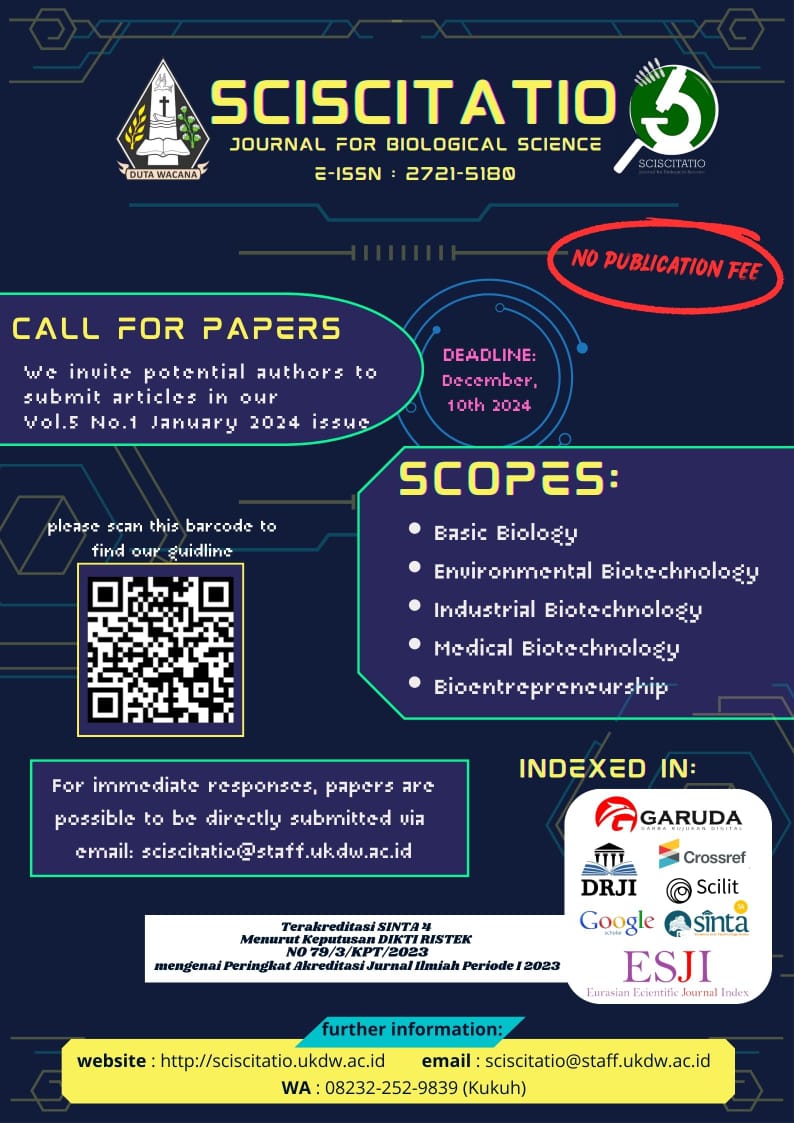Synthesis of Biodiesel from Kesambi Oil using Indigenous Lipase
DOI:
https://doi.org/10.21460/sciscitatio.2020.11.14Keywords:
Kesambi oil, lipase, A.niger M1407, biodiesel characterizationAbstract
Kesambi (Schleichera oleosa L.) is one of ligneous tree that is abundantly found in Timor island, East Nusa Tenggara Province of Indonesia. Kesambi is known as an important component in local smoked meat home industry. Kesambi is also a promising natural source for the production of biodiesel. Application of three lipolytic fungi that is isolated from kesambi seeds and the use kesambi seeds flour as medium for indigenous lipase synthesis (Aspergillus niger M1407 lipase) by Solid-State Fermentation (SSF) showed good result for lipase and biodiesel industry development. This study aimed to characterize biodiesel synthesis using indigenous lipase from kesambi seeds. Experiments were carried out through five stages namely: oil extraction from kesambi seeds, purification of kesambi oil (degumming), extraction of A. niger M1407 lipase, trans-esterification and esterification activity of A. niger M1407 lipase assay and characterization of biodiesel. Biodiesel synthesis using A. niger M1407 lipase through esterification reaction produced biodiesel with an average acid number of 0.33 and 0.40 mg/g, water content 9.52 % and 10.47 % and density 0.7 g/mL. Biodiesel obtained from kesambi oil has lower acid numbers and densities but higher water content compared to Indonesian National Standard (SNI) value. Optimalization of the biodiesel kesambi oil synthesis could be done through adjusting ethanol and kesambi oil ratio and also by reducing water as a by-product of esterification reaction
References
Bachli, Y. (2007). Plant Kesambi and Farming Flea for Welfare. Bulletin of Ministry of Agriculture, 1 (3).
Bajpai, D & V. K. Tyagi. (2006). Biodiesel: Source, Production, Composition Properties and Its Benefits. Jurnal Oleo Science, 55: 487-502.
Canakci, M & Van Gerpen, J. (1999). Biodiesel production via acid catalysis. Transaction of the ASAE, 42: 1203-1210.
Champe C. P., Harvey, A. R., Ferrier, R & Denise. (2010). Biochemistry Picture Review Edition 3. Jakarta: EGC.
Demirbas, A. (2009). Biodiesel from Waste Cooking Oil Via Base-Catalytic and Super Critical transesterification. Journal of Energy Conversion and Management, 50: 923-927.
Dosanjh, N. S & Kaur, J. (2002). Immobilization, Stability, and Esterification Studies of A. Lipase from Bacillus sp. Journal Biotechnology and Applied Biochemistry, 36: 7-12, Punjab University
Chandigarh. Formo M. W. (1979). Physical Properties of Fats and Fatty Acids. In The Bailey’s Industrial Oil and Fat Products. Vol 1,4th Ed. John Wiley and Sons, New York.
Fukuda, H., Kondo, A., & Noda, H. (2001). Biodiesel Fuel Production by Transesterification Oil. Journal Bioscience and Bioengineering, 92: 405-416.
Hasan, F., Shah, A. A., & Hameed, A. (2006). Industrial Aplication of Microbial Lipases, Microbial research Laboratory. Department of Biological, Quid-i-Azam University, Islamabad Pakistan
Haryanto, B. (2002). Alternative Biodiesel Fuels: Introduction. Faculty of Engineering, Chemical Engineering Department, University of North Sumatra, Medan.
Ledo, M. E. S., Dima, Y. R., & Nope, J. V. V. (2016). Lipolytic Activity Aspergillus niger and Penicillium sp. Indigenous isolated from seeds Kesambi (Schleichera oleosa). Proceedings of the National Seminar Science and Techniques University of Nusa Cendana, Kupang.
Ledo, M. E. S & Sabuna, A. C. (2015). Production Lipase by Aspergillus niger with Utilization of seeds Kesambi (Schleichera oleosa) as Medium Through Solid State Fermentation. Journal of Biotropikal Science, Vo. 12, no. 1, April 2015, University of Nusa Cendana, Kupang.
Sana, N. K., Hosin., Haque., & Ranajit, K.S. (2004). Identification, Purification, and Characterization of Lipase from Germinating Oil Seeds (Brassica napus L.). Bangladesh: University of Rajsahi.
Saxena, R. K., Ghosh, P. K., Gupta, R., Davidson, S., Bradoo, S., & Gulati,R. (1999). Microbial Lipases Potential Biocatalyst for the Future Industry. Curr Sci. 77: 101-115.
Saxena, R. K., Davidson, W. S., & Sheoran, A. (2003). Purification and Characterization of an Alkaline Thermostable Lipase from Aspergillus carneus. Process Biochemistry, 39 : 239-247.
Sele, Y & Ledo, M. (2013). Isolation and Identification of lipolytic fungi from kesambi seeds (Schleichera oleosa). Biotropical Journal of Science. University of Nusa Cendana, Kupang.
Seran, Y. K. (2011). Isolation, Characteristics, and Identification of the Main Fatty Acids of Kesambi Seed Oil (Schleichera oleosa (lour.). Thesis (Bachelor), Malang State University, Malang.
Srinivasnaik, M., Sudhakar., & Naik, B. (2015). Biodiesel as Alternative Green Fuel to Internal Combustion Diesel Engines. Journal of Industrial Engineering and Management Sciensce, 5 (2) : 63-66.
Sudrajat, R., Pawoko, E., Hendra, D., & Setiawan, D. (2010). Making Biodiesel from Kesambi Seeds (Schleichera oleosa
L.). Journal of Forest Products Research, 28 (4): 358-379.


